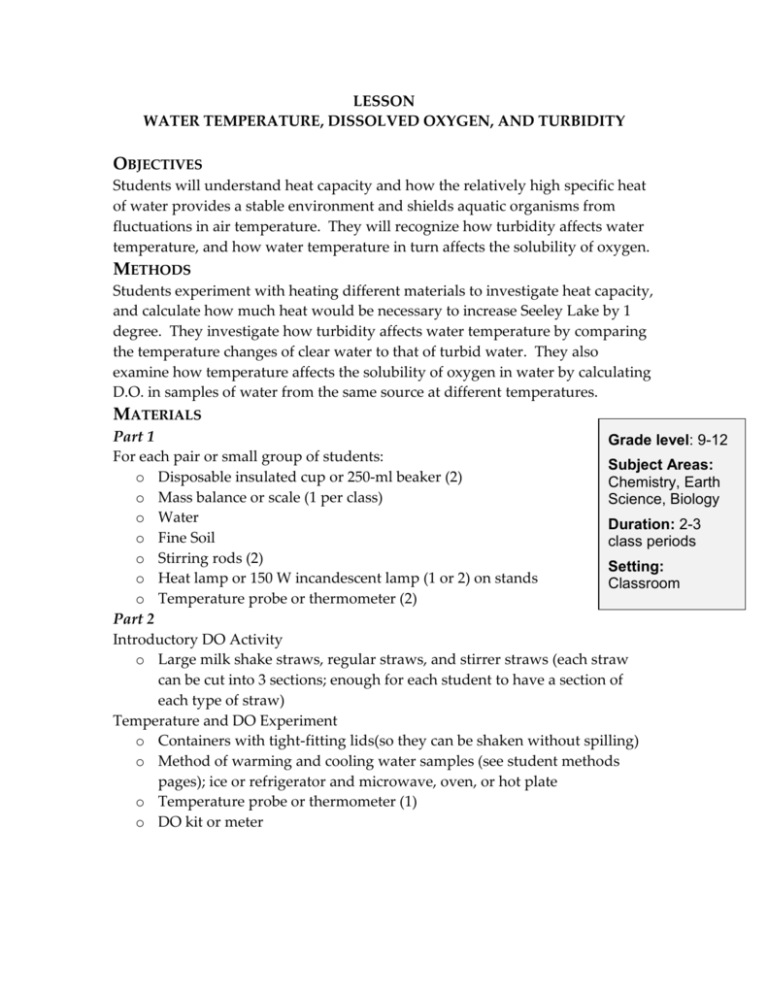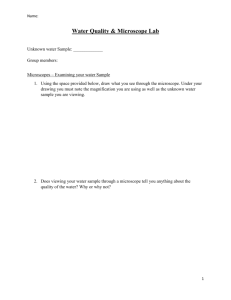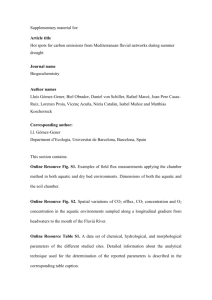Lesson Temperature, DO, and Turbidity
advertisement

LESSON WATER TEMPERATURE, DISSOLVED OXYGEN, AND TURBIDITY OBJECTIVES Students will understand heat capacity and how the relatively high specific heat of water provides a stable environment and shields aquatic organisms from fluctuations in air temperature. They will recognize how turbidity affects water temperature, and how water temperature in turn affects the solubility of oxygen. METHODS Students experiment with heating different materials to investigate heat capacity, and calculate how much heat would be necessary to increase Seeley Lake by 1 degree. They investigate how turbidity affects water temperature by comparing the temperature changes of clear water to that of turbid water. They also examine how temperature affects the solubility of oxygen in water by calculating D.O. in samples of water from the same source at different temperatures. MATERIALS Part 1 Grade level: 9-12 For each pair or small group of students: Subject Areas: o Disposable insulated cup or 250-ml beaker (2) Chemistry, Earth o Mass balance or scale (1 per class) Science, Biology o Water Duration: 2-3 o Fine Soil class periods o Stirring rods (2) Setting: o Heat lamp or 150 W incandescent lamp (1 or 2) on stands Classroom o Temperature probe or thermometer (2) Part 2 Introductory DO Activity o Large milk shake straws, regular straws, and stirrer straws (each straw can be cut into 3 sections; enough for each student to have a section of each type of straw) Temperature and DO Experiment o Containers with tight-fitting lids(so they can be shaken without spilling) o Method of warming and cooling water samples (see student methods pages); ice or refrigerator and microwave, oven, or hot plate o Temperature probe or thermometer (1) o DO kit or meter BACKGROUND Heat is the energy transferred between pieces of matter that are of different temperatures. Heat energy always moves spontaneously from items of higher temperature to those of lower temperature. The amount of heat transferred during a temperature change depends on the mass of the matter, the degree of temperature change, and the nature of the material itself. Different materials absorb heat energy at different rates. Specific heat is how much heat energy a gram of material must absorb before it increases by 1°C. Water has a very high specific heat—the highest of any common substance. (For comparison, the specific heats of some common materials are shown in the following table). Specific Heats of Various Substances Substance Specific Heat (cal/gram °C) Specific Heat (J/kg °C) water (pure) 1.00 4186 wet mud 0.60 2512 ice (0 °C) 0.50 2093 sandy clay 0.33 1381 dry air (sea level) 0.24 1005 quartz sand 0.19 795 granite 0.19 794 The high specific heat of water is essential in regulating extremes in the environment. For example, it means the temperature of bodies of water will vary relatively little from day to night, allowing aquatic organisms to maintain their internal temperatures relatively easily. On a world-wide scale, the oceans and lakes help regulate the temperature ranges the world experiences every day and every year. Water masses take longer to heat up and longer to cool down than do land masses, so areas near the oceans will tend to have less change and less extreme temperatures than inland areas. Even lakes can influence the temperature ranges of a smaller area around them. This is one reason why places like Seattle, Washington have much more moderate temperatures than drier inland areas at the same latitudes, such as Great Falls, Montana. Water’s high specific heat also makes it a good coolant material, and allows you to put out a candle with your fingers by wetting them beforehand! Specific heat can be calculated by the following equation: c = q/(m• ΔT) where q is the quantity of heat transferred to or from the object, m is the mass of the object, c is the specific heat capacity of the material, and ΔT is the resulting temperature change of the object. Water turbidity increases water temperatures because suspended particles absorb more heat. Increased water temperature in lakes and streams decreases the absolute amount of oxygen that can dissolve in the water and therefore reduces the amount of oxygen available for aquatic organisms, as warmer water can’t hold as much oxygen as colder water. PROCEDURE Part 1: Specific Heat of Water Students working in teams place equal amounts of soil and water into two separate containers. Heat lamps are used to heat both substances equally for 15 minutes. The temperatures of both substances are recorded and graphed for the heating period and for an equal amount of cooling time. These data are used to discuss and compare the specific heats of sand and water. Introduce the topic and experiment by discussing the following with your students (use the accompanying PowerPoint if desired): What would happen if you put a dry sponge under a trickling faucet? The sponge would absorb the water until at a certain point water would start to drip from it. You could say that the sponge had a water capacity. It could hold so much water before it couldn’t hold any more and the water started dripping out. Heat capacity is similar. Heat capacity is how much heat an object can absorb before it increases in temperature. The mass of an object influences its heat capacity (like a large sponge can hold more water than a smaller sponge), and so does the material itself. Think of putting a piece of wood under a faucet. How would this compare to the sponge? The water would begin to drip out sooner, right? It wouldn’t have much water capacity compared to a sponge. Similarly, different types of substances have different capacities for absorbing heat. This is referred to as the specific heat of a substance. Specific heat is how much heat energy a single gram of material must absorb before it increases 1°C. Each material has its own specific heat. The higher a material’s specific heat, the more heat it must absorb before it increases in temperature. Explain that you’ll be exploring the specific heats of water and earth with an experiment. Ask them to think of ways they could do this. Discuss dependent and independent (or experimental and control) variables. Prompt them if necessary to make sure they think about equalizing or at least accounting for amounts (mass), starting temperatures, and the heat energy put into each substance. Depending on how much time you want to put into letting your students brainstorm and develop ideas for an experiment, they may come up with the same basic design, some of its elements, or a variation on it. When the class is finished brainstorming, briefly describe the setup and hand out the student pages. (Note: depending on your resources, you can have students either set a heat light over each cup, or set one light at equidistance between and above the two cups.) Supervise students as they go through the experiment, answering questions and troubleshooting as necessary. When they have finished the experiment, you can have them answer the questions on their own or discuss them as a class. When they have finished the first part of the experiment, you can either have them figure out how to set up a test comparing the heat capacity of turbid water to that of clear or distilled water, or you can help them set it up by having them compare one cup with 300 grams of water to one cup with 150 grams of water and 150 grams of sand, stirring both samples occasionally, and monitoring the temperature changes. Again, discuss their results and what they might mean for lakes and streams. Extension: If you know of local sources of surface water of different turbidities, you can have students collect samples from each source and see if they can detect differences in their heat capacities. Part 2: Water Temperature and Dissolved Oxygen Begin with the following introductory activity: Available Oxygen Introductory Activity 1. Gather materials: Large milk shake straws, regular straws, and stirrer straws. Cut each straw into 3 sections, and cut enough straws so each student has 3 sizes of straws. 2. Tell the students that you are going to limit a very necessary ingredient for life: oxygen. They will be allowed to breathe only the oxygen they can pull through the straws you will give them. a. Hand out the large straws. Ask students to breathe only through the straw in their mouth. b. Have them stand and jog in place. c. Hand out the medium sized straws and repeat the steps. Hand out the small straws and ask the students to only breathe through the small straws. Caution them to stop and sit down, breathing normally, if they begin to feel dizzy. 3. Discuss with students the difference between terrestrial life’s access to oxygen and aquatic life’s access to oxygen. Just like the straws restricted oxygen amounts, living in water restricts the amount of oxygen available, as water can only contain so much dissolved oxygen. Experiment: Temperature Effects on Dissolved Oxygen Explain that now you’ll study the effects of temperature on dissolved oxygen in water. Share a little background information on dissolved oxygen using the rest of the PowerPoint, and then have them begin their experiment. You can have them collect water samples, or you can have them ready ahead of time, depending on the time you have available. Because some of the water should be at room temperature, this may affect how many class periods you use for the experiment. At the end of the lesson, discuss how these factors relate to streams and lakes in their area, and why they and scientists are concerned about monitoring water quality elements like turbidity and water temperature. (Use the last 3 PowerPoint slides to discuss DO saturation and the effects of temperature and DO on aquatic life.) For more information: http://www.waterontheweb.org/under/waterquality/temperature.html http://www.waterontheweb.org/under/waterquality/oxygen.html STUDENT PAGES Experiment: Specific Heat of Water and Soil Today you’re going to explore the specific heat of water and of earth (in the form of soil). If you want to compare the differences only between the two types of substances, what other variable(s) will you need to control, or keep constant, to make your experiment a fair test? 1. Place one of your cups on the scale and add 300 grams of sand. Fill the second cup with 300 grams of water. 2. Mount or stand the lights so that the bottoms of the bulbs are about 30 cm directly above the top of their respective cups. 3. Place one temperature probe in the sand so that the tip of the probe is about 1 cm below the surface. Place the other probe so that its tip is about 1 cm below the surface of the water. Secure both in place with a clip or clothespin. 4. Wait three minutes. Record the initial temperature of each substance in Table 1. 5. Turn the lights on at exactly the same time and record temperatures from both probes each minute for 15 minutes. Record your data in Table 1 to keep track of the temperature changes as they happen. 6. After 15 minutes, turn the lamps off and continue to collect temperature data for another 15 minutes. Graph your data when you have completed this process. 7. Answer the following questions and be prepared to discuss them in class. Questions 1. Which received more energy from its lamp, the sand or the water? Or did they receive the same amount? 2. According to your graph, which substance gets warmer more rapidly? How does your graph illustrate this? 3. According to your graph, which cooled down more rapidly? 4. Using the term specific heat, explain your results. 5. Describe some ways that the specific heat of water affects the environment in which aquatic organisms live. Can you also think of some ways it affects you? 6. The specific heat of pure water has been calculated to be 1.00 cal/gram °C (Specific heat can be calculated by the following equation: c = q/(m• ΔT), where q is the quantity of heat transferred to or from the object, m is the mass of the object, c is the specific heat capacity of the material, and ΔT is the resulting temperature change of the object.) Rearrange this formula to calculate the amount of heat energy it would take to raise the temperature of Seeley Lake by 1 degree Celcius: 7. What do you think would happen if fine particles of sand or soil were suspended in the water? Would it affect the heat capacity of the water? If so, how? How can you test this hypothesis? Carry out an experiment to test it, using the materials you have on hand and paying attention to your dependent and independent variables. 1. 2. 3. 4. 5. 6. 7. STUDENT PAGES Experiment: Water Temperature and Dissolved Oxygen Collect your water sample. You will need enough for at least 3 D.O. tests; your teacher will let you know how much you’ll need to collect depending on how you are testing for D. O. Record the temperature of the water and take a baseline dissolved oxygen measurement when you collect the sample. In the lab, divide your water sample equally into three separate containers with tight-fitting lids. For container 1: a. Add enough ice to container 1 (or refrigerate it) to bring the water to about 5°C. When the sample has cooled, record the temperature and measure the dissolved oxygen concentration. b. Next, pour out enough water to leave your container about half full. Aerate the sample by putting the lid on and shaking it vigorously for 3-4 minutes. Check the temperature periodically and add more ice if needed to maintain the temperature. c. When the water has been aerated, repeat the dissolved oxygen test and record the temperature. Warm the water in container 2 slightly. Follow your teacher’s directions to warm the water to about 35-40°C. Run similar tests (aerated and nonaerated) for container 2, as you did for container 1, and record your results. Run similar tests (aerated and non-aerated) for container 3, when it reaches room temperature (it may take a few hours to equilibrate, depending on how cold the sample was to start). Copy down the results from the other groups in your class. Then, find a class average for each. Sample Baseline Chilled Chilled, Aerated Room temp Room temp, Aerated Warmed Warmed, Aerated Temp °C DO Class ave. DO % saturation Questions: 1. Which of the four samples of non-aerated water had the highest DO level? Why do you think you saw this result? 2. Did shaking seem to affect the DO levels at all? If so, how? How might you relate this to DO levels in surface water in a stream? What kind of DO levels do you think you might see in water collected from riffles or rapids in Morrell Creek? How different are your results compared to the average values? Explain the possible reasons for the variability. 3. How did your results differ from your prediction? If your results were different, why did this occur? How do you think temperature affects oxygen levels in water? 4. What are some ways that dissolved oxygen could enter the water in a river? In a lake? 5. Why is dissolved oxygen important in surface water? 6. What do you think would happen to the aquatic organisms if the dissolved oxygen levels became too low? 7. When water contains all the oxygen it can hold, it is considered 100% saturated with DO. If it has half as much as it could potentially hold, it is 50% saturated. How much oxygen water can hold varies with temperature, as you may have surmised from the results of your experiment. Colder water can hold more oxygen. Use the chart below to calculate the percent saturation of oxygen in your samples. To calculate percent saturation, find the ppm of oxygen on the lower line and the water temperature on the upper line. Use a straight edge to line up the two readings and record where the straight edge intersects the percent saturation line. 8. According to the information below, how would aquatic life fare in the water samples you tested? For mg/L: 0-2 mg/L: not enough oxygen to support most animals 2-4 mg/L: only a few kinds of fish and insects can survive 4-7 mg/L: good for most kinds of pond animals 7-11 mg/L: very good for most stream fish For percent saturation: Below 60%: poor quality, bacteria may be using up the DO 60-79%: acceptable for most stream animals 80-125%: excellent for most stream animals 125% or more: too high 9. How could rises in water temperature affect fish, macroinvertebrates, and other aquatic organisms in Morrell Creek, Seeley Lake, the Clearwater River, and other local waterways? 10. You’ve already investigated one influence on water temperature (turbidity); can you think of some other things that can raise water temperatures in streams?





